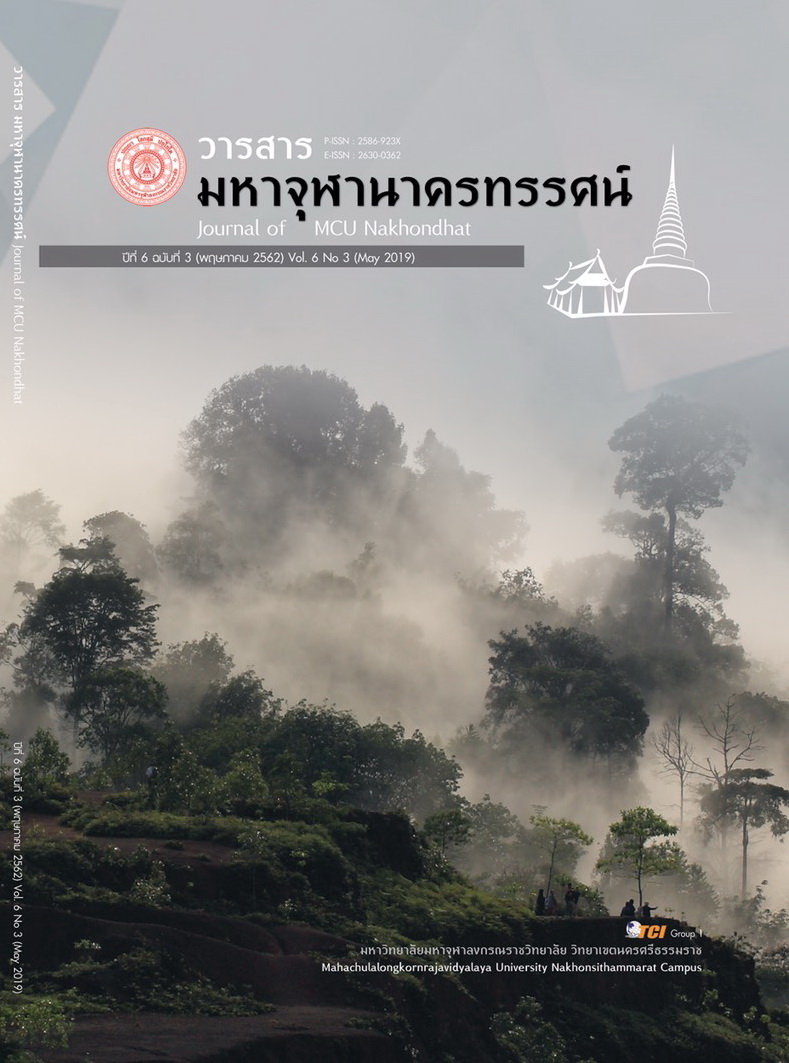DEVELOPMENT OF TEACHING AND LEARNING EUCATIONAL INNOVATION OF PHRAPARIYATTIDHAMMA SCHOOLS, GENERAL EDUCATION DIVISION
Main Article Content
Abstract
The objectives of this research are 1) to study the problems and problems of innovation in teaching and learning of Phra Pariyatidhamma School Department of General Education 2) for the development of innovative teaching and learning management at the Phrapariyattidhamma School Department of General Education 3) to present the teaching and learning innovation of Phra Pariyatma School Department of General Education By using a mixed method research methodology qualitative Research Methodology with Documentary Research by studying the relevant research papers, giving out the sample questionnaires of 556 images / person and creating a semi-structured interview form for in-depth interviews (In- depth interview from 5 key informants / innovation development group by Focus group discussion, 10 Using tools is an unstructured in-depth interview And data analysis by content analysis And quantitative research To examine educational innovations by handing out questionnaires in accordance with 4 assessment standards, namely 1) benefits, 2) feasibility, 3) suitability, 4) accuracy, sample number 201 images / person, statistics used for analysis Data on average, percentage and standard deviation
The research found that:
The problem of teaching and learning innovation is the teachers lacking the development of teaching and learning innovation 2 types 1) Media, inventions, teaching 2) Teaching methods According to studies, it has been found that The educational innovation in teaching and learning needs the most need is 1) Media, skill set and teaching method, activity format 2) Media, storytelling series 3) Form of teaching method, 4 MAT 4) CIPPA MODEL and 5) game media
The development of educational innovation in teaching and learning from research found that: 1) Educational innovations in teaching and learning materials, inventions (1) Media skills training sets Teaching innovation is the Buddhist intelligent lesson, exercises, skills training, Kahoot, Buddhist genius training. (2) The media for the teaching of innovative teaching Fairy tale story legendary stories, fun stories, folk tales, fun, and role-playing. Thai folk tale skills training (3) Innovative game media series, teaching games, wheel games, Dharma games, picture matching games, picture editing games, puzzles, group work, games, QR Test code, matching game, Buddhist history, not forgetting, practice Buddhism into Thailand 2) Teaching methods The teaching method consists of (1) CIPPA MODEL teaching and learning innovation. Buddhist disciples exercise, group work, QR test code, Buddhist disciples, leading disciples (2) Teaching 4 MAT, teaching and learning innovation Manage cooperative learning, Jigsaw techniques, Buddhist skills training, QR test code, Buddhist skills training (3) Activity-based teaching Innovation in teaching and learning, teaching process, practice, formal practice, Kahoot, practice of ordinance skills
Examination of the development of teaching and learning innovation at Phrapariyattidhamma School Department of General Education Research indicates that the overall picture is at the highest level, in descending order, from the least to the most. With the highest average level, followed by the next possibility is accuracy and the lowest mean is Suitability with average values respectively.
Article Details
References
กองพุทธศาสนศึกษา. (2558). แผนยุทธศาสตร์การจัดการศึกษาพระปริยัติธรรม แผนกสามัญศึกษา พ.ศ. 2558-2562. กรุงเทพมหานคร: สำนักงานพระพุทธศาสนาแห่งชาติ.
ชนาธิป แก้วบ้านดอน. (14 มกราคม 2561). นวัตกรรมทางการศึกษาที่สำคัญของไทยในปัจจุบัน. เข้าถึงได้จาก https://www.gotoknow.org/.
ฐานิตา นพฤทธิ์. (2556). นวัตกรรมการบริหารเทคโนโลยีสารสนเทศและการสื่อสารของโรงเรียนในฝัน. วิทยานิพนธ์ปริญญาดุษฏีบัณฑิต: บัณฑิตวิทยาลัย มหาวิทยาลัยศิลปากร.
บุญชม ศรีสะอาด. (2535). การวิจัยเบื้องต้น (พิมพ์ครั้งที่ 5). กรุงเทพมหานคร: สุวีริยาสาส์นการพิมพ์.
พระมหาธรรมรัต อริยธมฺโม (ยศขุน). (2555). แนวทางการจัดการศึกษาของคณะสงฆ์ในบริบทแห่งสังคมไทยยุคปัจจุบัน. วิทยานิพนธ์ศาสนศาสตรดุษฎีบัณฑิต สาขาวิชาพุทธศาสน์ศึกษา: บัณฑิตวิทยาลัย มหาวิทยาลัยมหามกุฏราชวิทยาลัย.
พิชิต ฤทธิ์จรูญ. (2553). การวิจัยและพัฒนานวัตกรรม. กรุงเทพมหานคร.
ไพฑูรย์ สินดารัตน์. (2560). ความเป็นผู้นำทางการศึกษา (พิมพ์ครั้งที่ 2). กรุงเทพมหานคร: โรงพิมพ์แห่งจุฬาลงกรณ์มหาวิทยาลัย.
สมนึก เอื้อจิระพงษ์พันธ์และคณะ. (2553). นวัตกรรม : ความหมาย ประเภท และความสำคัญต่อการเป็นผู้ประกอบการ. วารสารบริหารธุรกิจ 33 (124).
สุชาติ ประสิทธิ์รัฐสินธุ์. (2544). ระเบียบวิธีการวิจัยทางสังคมศาสตร์. กรุงเทพมหานคร: สำนักพิมพ์เฟื่องฟ้าพริ้นติ้ง.
สุดาภรณ์ อรุณดี. (2551). ยุทธศาสตร์การพัฒนาทรัพยากรมนุษย์สู่ระดับโลกในศตวรรษที่ 21 กรณีศึกษาการพัฒนาสมรรถนะทรัพยากรมนุษย์ตามหลักพุทธญาณวิทยาและรูปแบบการจัดการทักษะความรู้ (รูปแบบ SKM Model). วิทยานิพนธ์รัฐประศาสนศาสตรดุษฎีบัณฑิต สาขาวิชารัฐประศาสนศาสตร์: บัณฑิตวิทยาลัย มหาวิทยาลัยราชภัฏวไลยอลงกรณ์ในพระบรมราชูปถัมภ์.
สุภางค์ จันทวานิช. (2540). วิธีวิจัยเชิงคุณภาพ. กรุงเทพมหานคร: โรงพิมพ์แห่งจุฬาลงกรณ์ราชวิทยาลัย.
อินถา ศิริวรรณ. (2559). ประสิทธิภาพการบริหารจัดการการศึกษาโรงเรียนพระปริยัติธรรม แผนกสามัญศึกษาต้นแบบของคณะสงฆ์ไทย. วิทยานิพนธ์ศึกษาศาสตรดุษฏีบัณฑิต คณะครุศาสตร์ ทุนอุดหนุนจากมหาวิทยาลัยมหาจุฬาลงกรณราชวิทยาลัย: มหาวิทยาลัยมหาจุฬาลงกรณราชวิทยาลัย.
Calderon, L.A. (1989 49(9)). Characteristics of excellent teacher as perceived by students,teachers and administrators in the Los Angeles Community College District. Dissertation Abstracts International, 2512-A.
Wotruba, T.R. & Wright, P.L. (1975 46(6)). How to develop a teacher rating instrument. Journal of Higher Education, 653-660.


